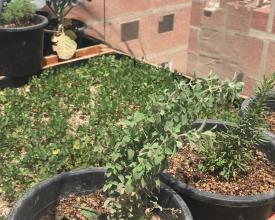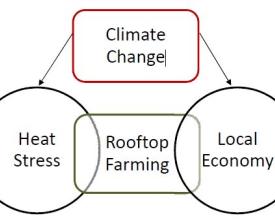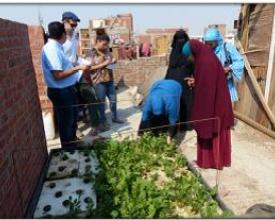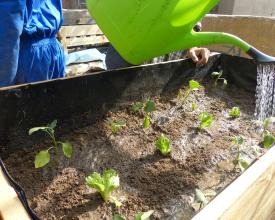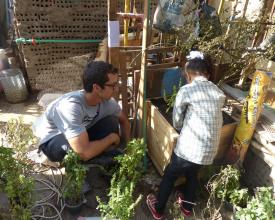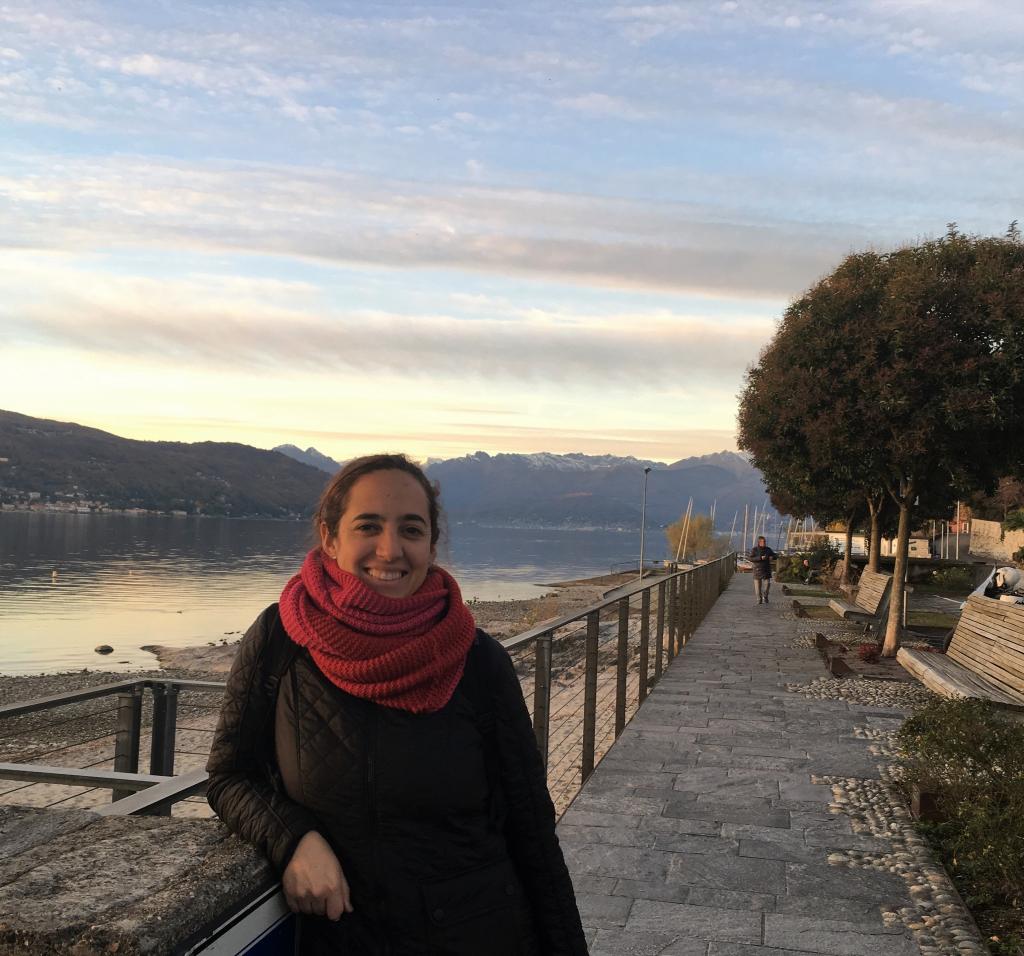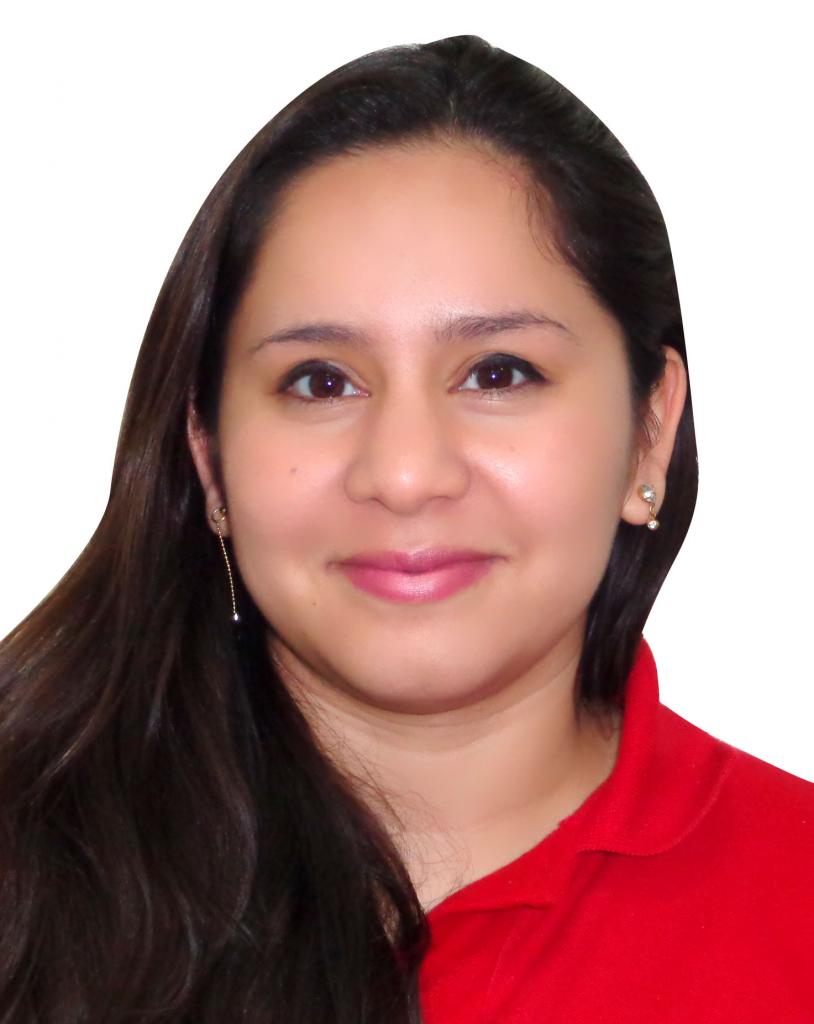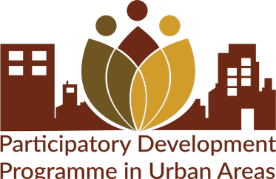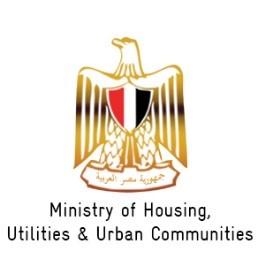
Une approche socio-économique de l'agriculture urbaine sur les toits dans la région du Grand Caire
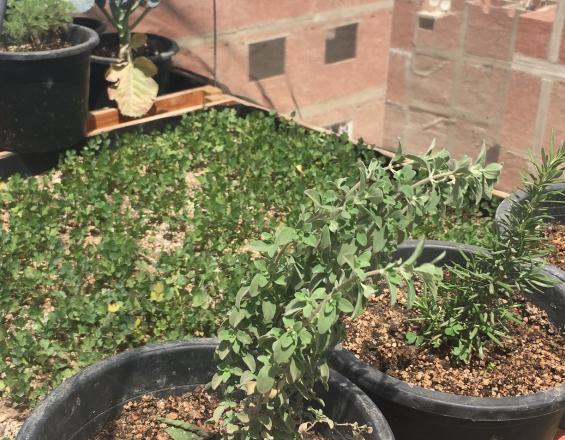
Dans les quartiers informels de la région du Grand Caire, un projet d'agriculture sur les toits a été lancé en 2014. L'objectif était de réduire les températures ambiantes (microclimat) dans une zone densément peuplée grâce à des espaces verts sur les toits, et de réduire les impacts de l'effet d'îlot de chaleur urbain et de l'augmentation de la chaleur due au changement climatique. Outre les avantages environnementaux, l'agriculture sur les toits présente d'autres avantages socio-économiques, en contribuant à la création de revenus et en réduisant la vulnérabilité aux hausses de prix. Étant donné que de nombreux défis ont été relevés concernant la durabilité et la poursuite du projet, un nouveau projet a été élaboré pour établir un modèle d'entreprise sociale afin de renforcer les aspects socio-économiques du projet, tout en envisageant l'agriculture sur les toits sous l'angle du développement de la communauté. Un centre d'agriculture sur les toits a été créé dans deux zones informelles afin de servir de moteur de changement technique, socio-économique et environnemental pour les membres de la communauté qui y participent.
Contexte
Défis à relever
Les conditions socio-économiques dans les quartiers informels du Caire s'aggravant avec l'augmentation des vulnérabilités climatiques, les mesures d'adaptation devraient être liées à la génération de revenus. Les récentes hausses de prix et la dévaluation de la monnaie locale représentent une opportunité, mais aussi un défi, car les membres de la communauté pourraient être plus motivés pour cultiver leurs propres aliments afin de réduire leur dépendance à l'égard des achats au marché, mais cela représente également un grand défi car le coût de l'agriculture sur les toits (coûts initiaux, de fonctionnement et d'entretien) est supérieur aux bénéfices générés par la vente des produits. Plus les conditions socio-économiques se détériorent, plus le seuil de rentabilité de ce projet d'agriculture collective se dégrade. L'absence de retombées économiques menace la continuité du projet. Le manque d'infrastructures dans ces zones, l'accès à l'eau potable, l'accessibilité des nutriments, ainsi que les conditions météorologiques difficiles, menacent encore plus la croissance des fermes sur les toits.
Emplacement
Traiter
Résumé du processus
Outre la mise en œuvre technique des fermes sur les toits (bloc 1), l'approche repose sur l'établissement d'un modèle d'entreprise sociale (bloc 2), ainsi que sur la coopération et le partage des connaissances entre les différentes parties prenantes (bloc 3). Le premier bloc de construction relève le défi de trouver les techniques les plus efficaces qui sont localement sensibles aux conditions socio-économiques. En outre, la structure du projet, le deuxième bloc de construction, relève le défi majeur de la durabilité du projet avec ses principaux piliers axés sur la durabilité technique, sociale et économique de l'agriculture sur les toits en tant que pratique locale. Sans la collaboration de la communauté et cette approche collective de l'agriculture, les agriculteurs sur les toits ne peuvent pas obtenir les mêmes gains, qu'ils soient financiers ou sociaux. Il est donc important de combiner ces trois éléments.
Blocs de construction
Méthodologie et technique de l'agriculture sur les toits
Un système de technologie hydroponique a été installé sur les toits. Le modèle se compose de 3 à 4 lits d'eau, directement attachés à chaque toit. Ils sont constitués de cadres en bois, de feuilles de plastique, de panneaux de mousse et de coupelles remplies de mousse de tourbe et de substrat de pyralite. L'eau d'une profondeur de 15 cm est alimentée par un tuyau d'eau via une connexion électrique à l'étage inférieur et entretenue par une pompe à eau et un filtre à eau. Comme alternative, le projet a installé des boîtes remplies de terre, qui ont l'avantage de ne pas nécessiter d'électricité pour la circulation de l'eau. Les plus grands défis pour les agriculteurs sur les toits ont été l'irrégularité de l'approvisionnement en eau et les coupures d'électricité, ainsi que les températures estivales élevées qui ont eu un impact négatif sur la croissance des plantes.
Facteurs favorables
Le choix de la culture dépendait en grande partie de l'étude de faisabilité et de marché ; il s'agissait de trouver un juste équilibre entre une culture très demandée sur le marché et très utilisée par la population, une culture à haut rendement pour renforcer les possibilités de création de revenus et une culture capable de résister aux conditions environnementales et climatiques de la région.
Leçon apprise
Le suivi : Un système de suivi doit permettre de recueillir des données sur la production alimentaire, les revenus, les activités agricoles, les coûts/bénéfices économiques, etc. Des mesures doivent être effectuées afin d'évaluer l'impact microclimatique réel. Installation technique : Le modèle hydroponique est relativement bon marché et donc abordable. Cependant, d'autres facteurs (entretien, consommation d'eau et d'électricité, utilisation de déchets organiques et d'eaux grises, impact sur les conditions microclimatiques) doivent être pris en compte pour la mise à l'échelle. D'autres options techniques que le système hydroponique devraient être explorées. Les goulets d'étranglement techniques restants doivent être résolus par l'expérimentation sur site. Impact : les toits à microclimat devraient être protégés du rayonnement solaire direct, favoriser le refroidissement par évaporation et permettre un effet plus important grâce au regroupement spatial et à une zone de mise en œuvre plus vaste.
Approche du modèle social d'entreprise
Le projet a établi deux centres d'agriculture sur les toits, un modèle d'entreprise sociale basé sur la communauté et intégré localement pour soutenir un écosystème d'agriculture sur les toits et développer une communauté de pratique dans le domaine de l'agriculture urbaine. Ce modèle est basé sur l'étude de différents marchés, produits, techniques agricoles, plans de commercialisation, ainsi que sur des accords de cofinancement entre la communauté et les centres RTF dans les deux zones ciblées. L'objectif n'est pas seulement d'éduquer et de former les résidents locaux des zones ciblées à la RTF, mais aussi de créer une plateforme grâce à laquelle les résidents peuvent collaborer, échanger des expériences, travailler en réseau, se soutenir et apprendre comment soutenir et développer leurs projets d'agriculture urbaine générateurs de revenus.
En tant que pôle technique, les bénéficiaires sont dotés des compétences et des outils nécessaires pour établir et entretenir leurs fermes sur les toits en tenant compte des conditions socio-économiques et en fournissant des connaissances et une assistance techniques permanentes.
En tant que pôle social, les liens entre les bénéficiaires ciblés sont renforcés afin d'échanger des connaissances sur la RTF, de consolider les expériences d'apprentissage, ainsi que de soutenir l'interaction positive et la cohésion de la communauté.
Entant que pôle économique, l'accès aux marchés locaux est facilité par un plan de marché qui vise à sensibiliser le public à l'agriculture urbaine biologique.
Facteurs favorables
Préparation d'une ONG ou d'une institution locale à accueillir un Hub RTF comme l'une de ses fonctions principales. Les "facilitateurs de plate-forme" ont reçu une formation approfondie sur les compétences techniques et pratiques en matière d'agriculture sur les toits, la gestion de projet, le marketing, la faisabilité et la sensibilisation. Ils ont ensuite été formés sur le terrain en recrutant des bénéficiaires communautaires qui ont rejoint le réseau d'agriculteurs sur les toits, en installant leurs fermes sur les toits, en les soutenant tout au long des saisons agricoles et en les aidant à nouer des liens avec le marché.
Leçon apprise
- La surveillance à distance devrait être appliquée tout au long du processus de mise en œuvre afin d'aider à résoudre tout problème lié à la croissance des plantes.
- La création d'activités incitatives pour les bénéficiaires contribuerait à la réussite du projet en encourageant une plus grande interaction de leur part ;
- Des filets devraient être installés pour protéger les cultures des attaques extérieures des oiseaux et des insectes volants ;
- Les formations devraient mettre davantage l'accent sur la résolution des problèmes au cours de la culture.
Création d'un réseau d'agriculteurs sur les toits
Un réseau d'agriculteurs sur les toits a été mis en place avec tous les membres de la communauté/les ménages participants, dans le but de créer une communauté de pratique. Comme les gens sont plus susceptibles de se désintéresser et de se démotiver, la création d'un système de soutien où les bénéficiaires peuvent échanger, partager leurs expériences, leurs défis, leurs pensées et même leurs rêves a prouvé qu'elle gardait les gens motivés et renforçait également les liens sociaux entre les membres de la communauté.
Facteurs favorables
Une plateforme d'échanges réguliers qui mobilise les agriculteurs des toits
Leçon apprise
- Échanges réguliers autour de différents thèmes pour susciter l'intérêt de l'agriculteur
- des visites pourraient être intégrées à ces échanges
- une communication continue, en particulier lors d'événements météorologiques extrêmes, est cruciale. Un groupe whatsapp a été créé pour permettre aux participants de rester en contact étroit avec les facilitateurs du Hub et de partager des photos de conditions végétales inhabituelles.
Impacts
Impacts environnementaux : Les toits verts améliorent le microclimat en contribuant à la réduction de la température à l'intérieur et à l'extérieur des bâtiments, ce qui a pour effet de les rafraîchir et d'augmenter la ventilation naturelle.
Impacts sociaux : Grâce au Hub RTF, un réseau d'agriculteurs sur les toits a été mis en place au sein des membres de la communauté participante, où un soutien social a été apporté, des défis ont été partagés, des préoccupations ont été communiquées et des idées ont été développées pour aider à renforcer chaque ferme collectivement. Des sessions d'échange sont régulièrement organisées pour améliorer la communication entre les agriculteurs de la RTF. Avec le soutien du Hub, les membres participants ont pu conserver une partie des récoltes pour leur usage personnel, ce qui les rend moins vulnérables aux hausses de prix. Les fermes sur les toits ont également fourni un nouvel espace de loisirs pour les familles et les enfants.
Impacts économiques : Le Hub a fonctionné comme un lien avec le marché local. Un plan de commercialisation a été mis en place en tenant compte des besoins de la communauté locale. Alors que les membres participants conservaient une partie de leurs récoltes pour leur usage personnel, une plus grande partie était collectée par le Hub auprès de tous les toits pour être vendue sur le marché. Les recettes ont ensuite été partagées avec les agriculteurs et utilisées pour financer les nutriments et l'entretien des fermes. La génération de revenus est donc une opportunité à mesure que ce projet se développe.
Bénéficiaires
Grâce au projet à grande échelle de 2017, environ 20 ménages/familles participent au réseau d'agriculture sur les toits, ainsi que 20 bénéficiaires supplémentaires qui ont été formés pour faire partie du Hub de la RTF et qui ont été en mesure d'intégrer de nouveaux ménages.
Objectifs de développement durable
Histoire
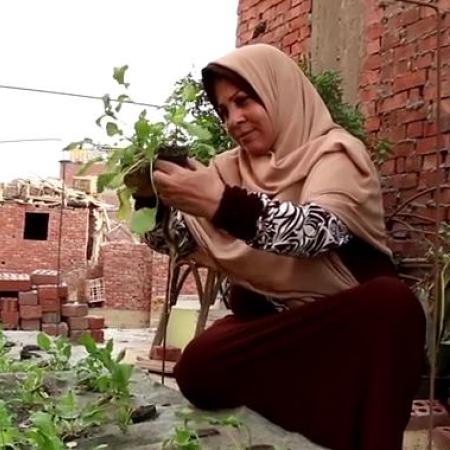
Neama est à la tête de l'ONG "Serious Work" et a été sélectionnée pour être formée avec quelques membres du personnel pour agir en tant que "Rooftop Farming Hub", un modèle d'entreprise sociale qui vise à soutenir l'établissement de fermes sur les toits dans leur communauté par le biais d'une approche de développement durable. Alors qu'elle hésitait à jouer ce rôle, après des formations approfondies et des programmes de développement des capacités, et après avoir aidé une quinzaine de ménages à mettre en place leurs fermes sur les toits, elle est désormais experte dans sa communauté et s'engage de plus en plus dans des projets environnementaux allant de l'agriculture sur les toits aux jardins communautaires. Le fait de voir non seulement le toit de sa propre entité se développer, mais aussi les toits des membres de la communauté devenir verts, l'a incitée à mener ses propres recherches sur les différentes solutions et à devenir un défenseur crucial de l'agriculture sur les toits et de son impact sur les communautés urbaines souffrant de l'effet d'îlot de chaleur urbain dans sa communauté, ainsi qu'auprès d'autres ONG de la région. Au fur et à mesure que sa passion pour le développement de cette entreprise sociale grandit, un certain nombre d'ONG l'ont approchée pour recevoir des formations de son groupe afin d'aider à répandre l'idée et la pratique dans d'autres communautés de la région du Grand Caire.
